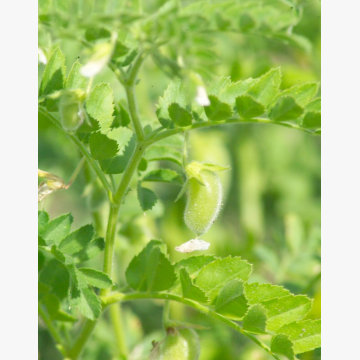- Home
- Seeds
- Spring cereals
- Chickpea
- Chickpea
Category: Spring cereals
FOR CONSULTATIONS APPLY TO:
Commercial director
Lina Smalskienė
tel. +370 618 02 551
e-mail linak@agrolitpa.lt
Sales manager
Tautvydas Kliučininkas
tel. +370 681 35 093
e-mail tautvydask@agrolitpa.lt
Sales manager
Eglė Petkevičienė
tel. +370 626 95 458
e-mail eglep@agrolitpa.lt
Sales manager
Kotryna Nakrošytė
tel.: +370 601 39 282
e-mail kotryna@agrolitpa.lt
Chickpea
Cicer arietinum
- Very productive
- Germination power – very good
- Nature of plant growth – erect
- The height of the plants – medium
- Stem – semi-erect
- Leaves – medium green
- Leaflets – large
- Soil coverage – excellent
- Resistance to lodging – very good
- Disease resistance – good
- Flowers – white
- Pods – 1.4-3.5 cm long, with 1-3 seeds (usually 1)
- Seeds – usually beige, but come in a variety of colours
- Weight of 1000 seeds – varies, depends on type and variety
- Seeds contain 18-26 % protein, 42-59 % carbohydrates (starch and sugar), 4-8 % fat
- The seeds are rich in molybdenum, folate, iron and potassium, have diuretic and digestive properties, and help lower cholesterol and maintain blood sugar balance
- The stems and harvested pods of the plant can be used for feed
- Seeds germinate at a soil temperature of 5° C. Does not tolerate high soil moisture
- It likes heat more than peas, but tolerates short spring frosts well
- It is sown in dry soils that have warmed up to 7-10 °C, in order to have at least 50 plants/m², sown at 3-4 cm depth, with 40-45 cm inter-rows
- The ideal break in crop rotation is 5 years
- Cultivation advantages: diversified crop rotation, good pre-sowing crop, accumulates nitrogen, enriches poorer soils, improves soil structure
- Rainfall of at least 400 mm per growing season is required
- These are plants with long vegetation. Warm weather is required during flowering and pod development (about 24 °C)
The varietal parameters may differ from those indicated here when the testing circumstances differ from quondam
Recommended seed rate: depends on the variety, the size of the seeds, the method of cultivation (60 plants/m², or 180-190-220 kg/ha)
UAB „Agrolitpa“
Keravos sreet. 17, Kerava,
LT-38 131 Panevėžys district, LITHUANIA
Enterprise's code 168598128
VAT code LT685981219
Tel. +370 615 11 315
E. mail info@agrolitpa.lt
Keravos sreet. 17, Kerava,
LT-38 131 Panevėžys district, LITHUANIA
Enterprise's code 168598128
VAT code LT685981219
Tel. +370 615 11 315
E. mail info@agrolitpa.lt




.JPG)

